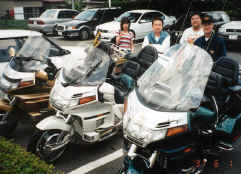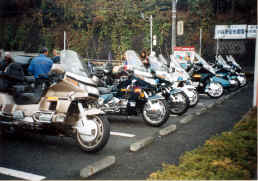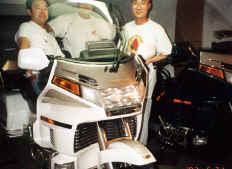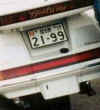 |
In Japan, vehicles drive on the
left side of the road, just like in England and Australia. |
 |
Motorcycles are not allowed to
have a passenger on highways. You must take secondary roads for two-ups. |
 | All highways are toll-ways. |
 | Until recently, maximum legal
speed limit for motorcycles was 50 mph or 80 kmph!! The law was
changed and now it is up to 62.5 mph or 100 kmph on highways. |
 |
Lane splitting and riding between
shoulder/curb and vehicles are legal. |
 |
Many intersections have motorcycle
stop zones in front of the regular stop line so motorcycles can lane-split and
get ahead of cages at traffic lights. |
 | Speed limit enforcement is more
lax in Japan than in the U.S. They use stationary photo radars, but
they are constantly on, so they can be easily detected. Police cruisers and
motorcycles are not equipped with radar guns. The police are required to
follow right behind you for a certain distance and match their speed with your
motorcycle's speed. Using a second speedometer, the police lock in
your speed. If you pay
attention to who's behind, you wouldn't get caught! |
 | Gasoline costs about 1.00 USD per litter
( little less than a quarter of a gallon). |
Traffic
 Now, please
keep in mind that I cannot speak for the entire country of Japan since my riding was
limited to Tokyo and its neighboring prefectures toward the west. My favorite
ride was around Mt. Fuji. Every weekend (as long as the weather was OK), I
woke up at about 5:00 a.m. and hit the road between 5:30 and 6:00 a.m. Why so early?
Well, unless you leave early, everybody in Tokyo would be trying to get out of the city,
and there would be a traffic jam by 7:00 a.m. I would ride around Mt.
Fuji area and go home by early afternoon to avoid the traffic jam on the return! I
missed riding with Amy. She is not an early-riser, so she wasn't willing
to get up that early. Plus, I couldn't take the highways with her due to
the traffic laws. Besides heavy traffic, what bothered me most was the exhaust pipes
of large
trucks and buses. In Japan, they are located on the the side or rear of
the vehicle. So, when you ride behind or beside of one of these trucks or
buses, you are
riding in the diesel exhaust. In fact, after wiping your face upon return
from riding through Tokyo, the towel turns black. I used to wish those
exhaust pipes would shoot out from the top like in
the U.S. Anyway, one thing for
sure, you get pretty good at slow riding and tight lane-splitting!
Now, please
keep in mind that I cannot speak for the entire country of Japan since my riding was
limited to Tokyo and its neighboring prefectures toward the west. My favorite
ride was around Mt. Fuji. Every weekend (as long as the weather was OK), I
woke up at about 5:00 a.m. and hit the road between 5:30 and 6:00 a.m. Why so early?
Well, unless you leave early, everybody in Tokyo would be trying to get out of the city,
and there would be a traffic jam by 7:00 a.m. I would ride around Mt.
Fuji area and go home by early afternoon to avoid the traffic jam on the return! I
missed riding with Amy. She is not an early-riser, so she wasn't willing
to get up that early. Plus, I couldn't take the highways with her due to
the traffic laws. Besides heavy traffic, what bothered me most was the exhaust pipes
of large
trucks and buses. In Japan, they are located on the the side or rear of
the vehicle. So, when you ride behind or beside of one of these trucks or
buses, you are
riding in the diesel exhaust. In fact, after wiping your face upon return
from riding through Tokyo, the towel turns black. I used to wish those
exhaust pipes would shoot out from the top like in
the U.S. Anyway, one thing for
sure, you get pretty good at slow riding and tight lane-splitting!
Meeting Japanese Wingers
 Before Amy and I returned to Japan from Mexico, We already knew
another Winger in Japan. Masahiro Tsuji, aka, Masa #2 on WOTI. He is
a member of Japan Gold Wing Party.
We invited him, the party leader, aka, Tank, and their family to our house
one weekend. They arrived on Saturday. Sunday morning, we rode
together around Mt. Fuji. Masa #2's wife drove a cage and followed
us. While on back roads, I got to ride with Amy, but when we were taking
the highways, she rode with the other wives and children in the cage. After
that weekend, I met with some of the members of Japan Gold Wing Party several
times. Very nice folks -- serious Gold Wing enthusiasts!
Before Amy and I returned to Japan from Mexico, We already knew
another Winger in Japan. Masahiro Tsuji, aka, Masa #2 on WOTI. He is
a member of Japan Gold Wing Party.
We invited him, the party leader, aka, Tank, and their family to our house
one weekend. They arrived on Saturday. Sunday morning, we rode
together around Mt. Fuji. Masa #2's wife drove a cage and followed
us. While on back roads, I got to ride with Amy, but when we were taking
the highways, she rode with the other wives and children in the cage. After
that weekend, I met with some of the members of Japan Gold Wing Party several
times. Very nice folks -- serious Gold Wing enthusiasts!
We lived in the City of Hachoji, located northwest of
Tokyo. The City
and its surrounding area happened to have quite
a few Wingers. There was a cycle shop specializing in Gold Wings, and there
was a Gold Wing club there. They had about 30 members. Amy and I
joined their Sunday morning ride once, and their year-end party. Again,
they were very nice folks. I guess you find the nicest people on Hondas!
few Wingers. There was a cycle shop specializing in Gold Wings, and there
was a Gold Wing club there. They had about 30 members. Amy and I
joined their Sunday morning ride once, and their year-end party. Again,
they were very nice folks. I guess you find the nicest people on Hondas!
Why only Wings for the Japanese market has factory installed
windshield wiper?
 After
I started riding in Japan on my Gold Wing, it was apparent that you NEED a
windshield wiper in Japan. You just can't
ride fast enough to get rid of the rain from the windshield due to traffic, speed
limits,
etc. Plus, it
rains a lot there, too. The factory
windshield wiper equipped with the Japanese models surely looks a lot better than the aftermarket ones!
Some U.S. Wingers have asked me about the possibility of installing the Honda
genuine windshield wiper. Well, there is one lister on the
Japanese discussion list who had added the factory windshield wiper to his older
1500, which did not come with a windshield wiper. It cost $700 just for the windshield wiper
After
I started riding in Japan on my Gold Wing, it was apparent that you NEED a
windshield wiper in Japan. You just can't
ride fast enough to get rid of the rain from the windshield due to traffic, speed
limits,
etc. Plus, it
rains a lot there, too. The factory
windshield wiper equipped with the Japanese models surely looks a lot better than the aftermarket ones!
Some U.S. Wingers have asked me about the possibility of installing the Honda
genuine windshield wiper. Well, there is one lister on the
Japanese discussion list who had added the factory windshield wiper to his older
1500, which did not come with a windshield wiper. It cost $700 just for the windshield wiper parts, plus an additional $200 if you wanted to have the windshield washer...
I doubt one would be willing to pay that much. Check
out this link to see how he installed the factory windshield wiper.
Follow the blue URL link to go to the following pages (yes, this site is in
Japanese). http://www.goldwing.to/techlab/genuine_wiper/wiper1.html
The white 1996 SE here belongs to Masa #2 in Japan. Note the windshield
wiper fluid filler cap right below the license plate and a peep hole for the
fluid tank on the rear fender.
parts, plus an additional $200 if you wanted to have the windshield washer...
I doubt one would be willing to pay that much. Check
out this link to see how he installed the factory windshield wiper.
Follow the blue URL link to go to the following pages (yes, this site is in
Japanese). http://www.goldwing.to/techlab/genuine_wiper/wiper1.html
The white 1996 SE here belongs to Masa #2 in Japan. Note the windshield
wiper fluid filler cap right below the license plate and a peep hole for the
fluid tank on the rear fender.
Favorite Rides in Japan
Since 80% of Japan is mountains, curvy roads and twisties are
easy to find. Such beautiful scenery. Like I said, earlier, my favorite ride was riding around Mt.
Fuji. Since Japan is volcanic islands, there are numerous hot
springs. The best thing during the rides was to stop by an onsen or
hot spring. It is so relaxing to sink yourself in an outdoor hot spring in a
remote area. I wish there were hot springs in Texas!
Enjoy the pictures from Japan! Remember, click on the pictures to
view high resolution version.













 Winging in Japan
Winging in Japan
